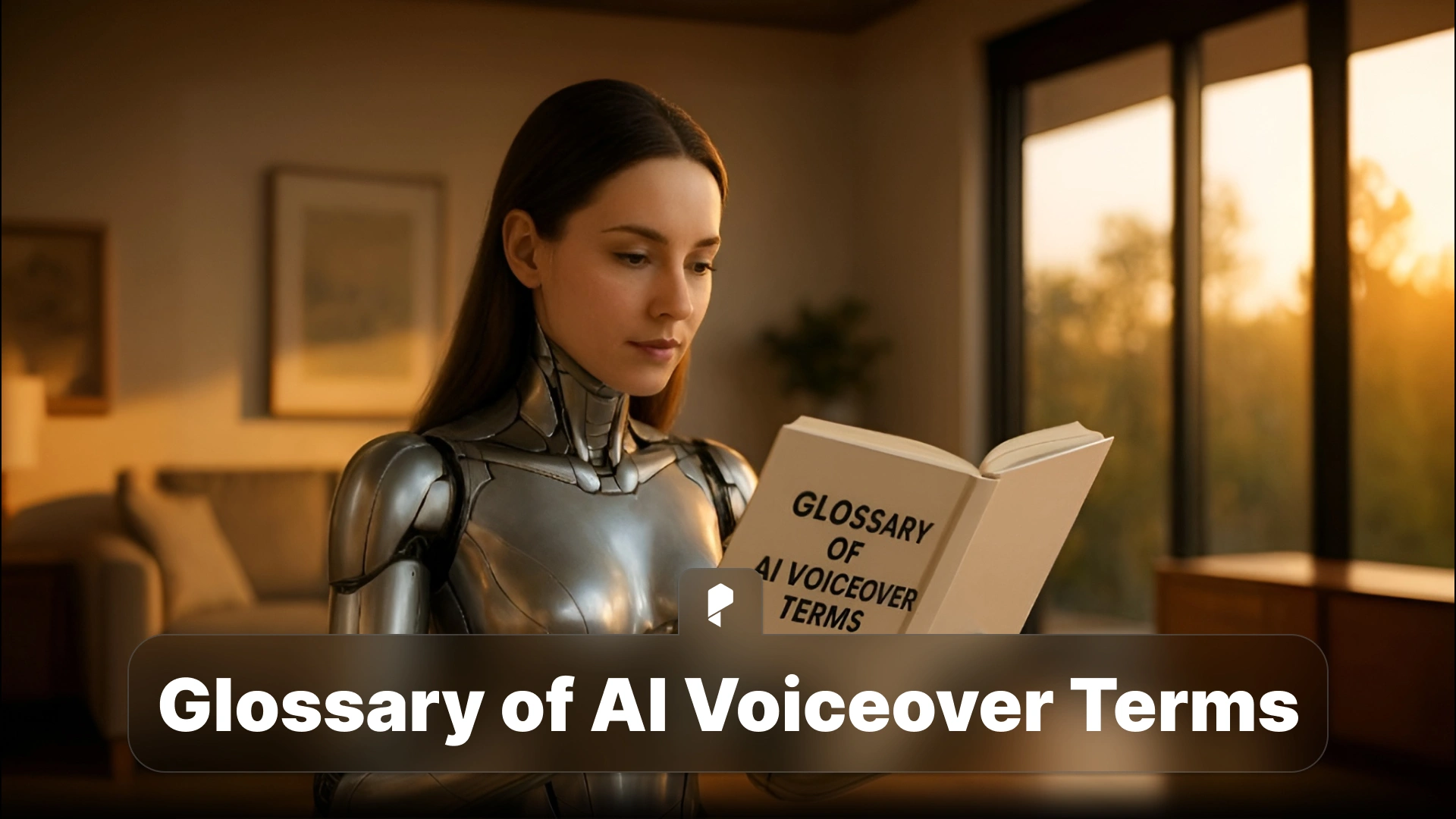Glossary of AI Voiceover Terms

Introduction
From terms like neural synthesis and SSML to formant and compression, each definition breaks down the technical jargon into plain English. These are the same concepts used across AI voiceover tools, modern production workflows, and creative industries worldwide.
If you want to dive deeper into how these technologies work, see AI Voiceovers: The Complete Guide.
How to Use This Glossary
Each term comes with a short, simple explanation so that even those new to AI audio production can follow along easily.
If you are just getting started with tools like text-to-speech (TTS) or neural voice systems, Pixflow’s AI Voiceover platform is a great place to experiment with the concepts you will learn here.
Core AI Voiceover Terms (A–Z List)
A – C
AI Voiceover
A synthetic voice generated using artificial intelligence models that can mimic natural human speech.
Accent Modeling
A process of adjusting pronunciation and tone to match specific regional or cultural accents.
Bitrate
The amount of data processed per second in an audio file. Higher bitrate means better sound quality.
Cloning (Voice Cloning)
Reproducing a person’s voice using AI by training on small voice samples.
Compression
A technique that evens out loudness levels to keep the voice clear and balanced. Learn what compression, EQ, and normalization mean in our Audio Quality Optimization for AI Voiceovers.
D – F
Dataset
A collection of voice samples used to train AI voice models. The larger and more diverse the dataset, the more realistic the result.
Deepfake Audio
Audio that mimics real voices using AI, often raising ethical questions. Learn more in Ethical Concerns in AI Voiceovers.
Fine-tuning
The process of customizing a pretrained AI model for a specific voice style, tone, or emotional delivery.
Formant
A frequency element that shapes the tonal quality of a voice, influencing how “natural” or “robotic” it sounds. Understand more about formant and related terms in AI Voiceovers in Film & Animation
G – L
GAN (Generative Adversarial Network)
A machine learning architecture where two models compete to create more realistic results, often used in neural voice synthesis.
Latency
The delay between giving an input and hearing the generated voice. Low latency is essential for real-time AI narration tools.
LUFS (Loudness Units Full Scale)
A unit for measuring perceived loudness in audio production. Understanding LUFS helps maintain consistent volume across AI-generated content.
M – P
Multilingual TTS
Text-to-speech systems capable of generating natural voices in multiple languages. Pixflow’s AI Voiceover tool supports over 29 languages for global creators.
Neural Synthesis
A modern AI approach where neural networks generate human-like voices by predicting natural speech patterns. Not familiar with TTS or neural synthesis? Check out The AI Models Behind Voiceovers (TTS, Neural Synthesis)
Phoneme
The smallest unit of sound in speech, used by AI to model pronunciation and natural articulation.
Pitch Correction
A process for adjusting the frequency or tone of a voice to convey specific emotions or maintain clarity.
Q – S
Sample Rate
The number of audio samples captured or played per second, typically measured in Hertz (Hz). Higher sample rates preserve more sound detail.
Speech-to-Text (STT)
Technology that converts spoken words back into text. It is often used alongside TTS systems for interactive applications.
SSML (Speech Synthesis Markup Language)
A language used to control pauses, emphasis, tone, and pronunciation in AI voices.
T – Z
Text-to-Speech (TTS)
The technology that transforms written text into spoken voice using AI models.
Tone Mapping
Adjusting a synthesized voice’s emotion and delivery to sound natural or fit the context.
Voice Font
A saved or reusable AI-generated voice model that can be applied to future projects.
Waveform
The visual representation of an audio signal that helps engineers analyze amplitude and structure.
Zero-Shot Learning
A method where AI generates entirely new voices without retraining the main model, saving time and data resources.
Why Understanding These Terms Matters
By knowing these terms, you can use tools like Pixflow’s AI Voiceover platform more effectively. It enables better creative direction, faster troubleshooting, and more precise customization.
Learning this vocabulary also builds literacy in the technology shaping the future of content creation. From podcasts to film dubbing, AI-generated voices are here to stay, and understanding the basics is the first step toward mastering them.
Conclusion
We recommend you bookmark this guide and revisit it as the field evolves. The language of AI audio changes quickly, and new terms emerge with each breakthrough. Our blog will keep updating this glossary to include the latest definitions, tools, and best practices.
Whether you are exploring advanced neural synthesis or just getting started with TTS, visit Pixflow’s AI Voiceover platform to experience how these technologies come to life. It is where creativity meets cutting-edge sound design, giving you the power to create voices that inspire.
Disclaimer : If you buy something through our links, we may earn an affiliate commission or have a sponsored relationship with the brand, at no cost to you. We recommend only products we genuinely like. Thank you so much.





